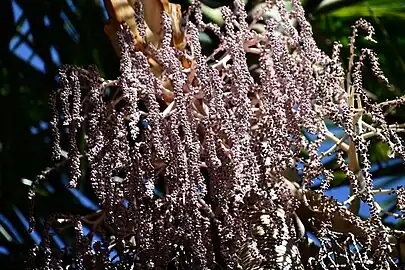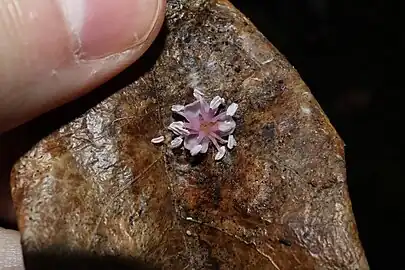| Bangalow palm | |
|---|---|
 | |
| Growing on the Gold Coast, Queensland | |
| Scientific classification | |
| Kingdom: | Plantae |
| Clade: | Tracheophytes |
| Clade: | Angiosperms |
| Clade: | Monocots |
| Clade: | Commelinids |
| Order: | Arecales |
| Family: | Arecaceae |
| Genus: | Archontophoenix |
| Species: | A. cunninghamiana |
| Binomial name | |
| Archontophoenix cunninghamiana | |
| Synonyms[4] | |
Archontophoenix cunninghamiana – commonly known as Bangalow palm, king palm, Illawara palm or piccabeen palm – is a tree in the palm family Arecaceae which is endemic to the east coast of New South Wales and Queensland, Australia.
Description
The Bangalow palm has a single trunk growing up to 30 m (98 ft) tall and a diameter of 30 cm (12 in).[5][6][7] The trunk is swollen at the base and is marked by prominent leaf scars at regular intervals along its length.[5][6] The crownshaft is around 140 cm (55 in) long and is green or purple green.[6][7] Around 9 to 12 leaves (or fronds) make up the crown, each about 4–4.5 m (13–15 ft) long and with around 90 pairs of leaflets.[5][6][7] The fronds usually have a half-twist so that the leaflets at the distal end are more or less vertical. The leaflets measure up to 100 cm (39 in) long and 10 cm (3.9 in) wide.[5][6][7]
The inflorescence is a much-branched panicle arising from the base of the crownshaft, and measuring up to 150 cm (59 in) long.[5][6][7] The flowers are pink to lilac or purple; the staminate (functionally male) flowers measure up to 6 mm (0.24 in) long and the pistillate (functionally female) flowers are around 5 mm (0.20 in) long.[5][6][7]
The globose fruit is a drupe to around 10–15 mm (0.39–0.59 in) diameter. They are bright red when ripe and contain a single seed.[5][6][7]
Taxonomy
This species was first described in 1858 by the German botanist Hermann Wendland, who gave it the name Ptychosperma cunninghamianum.[3] Seventeen years later, working with his countryman Carl Georg Oscar Drude, Wendland reviewed his description and gave the species the current combination. Their work was published in the journal Linnaea: ein Journal für die Botanik in ihrem ganzen Umfange, oder Beiträge zur Pflanzenkunde in 1875.[3][4]
Etymology
The genus name is derived from the Ancient Greek ἄρχων (árkhōn), meaning "chieftain" or "ruler", combined with the palm genus Phoenix. It was created by Wendell and Drude and refers to their perceived "regal stature" of these palms. The species epithet cunninghamiana was coined by Wendland to honour the English botanist Allan Cunningham.[8]
Distribution
The native range of the Bangalow palm is from Mount Elliot, near Townsville in tropical Queensland, southwards in coastal and sub-coastal areas to Bateman's Bay in southern New South Wales.[5][6][7] It grows in rainforest and wet scleophyll forest, in swampy areas and beside rivers and creeks. at altitudes ranging from sea level to 1,200 m (3,940 ft).[5][6][7][8]
Ecology
Its fronds do not create a nesting environment for insects or macrofauna like rodents, so are a tolerable tree for urban environments. They arrived in Australia from the landbridge created 45,000 years ago due to the receding ocean levels during the last glacial period, but the probable 'native' environment in prehistory was Indonesia.
Invasive potential
It has become a noxious weed in many areas where it has been used as an ornamental plant. In southern Brazil, it has become an invasive species, and it has been suggested that it benefits from the earlier local extinction of the native palm Euterpe edulis.[9]
In New Zealand, A. cunninghamiana could invade native forests, since it has the same ecological requirements as the native nīkau palm.[10] The Auckland Council has declared A. cunninghamiana to be a pest species, and has introduced restrictions on the movement of the plant within the Hauraki Gulf Controlled Area.[11]
In the United States, the palm is commonly cultivated in California from San Luis Obispo south to the Mexican border and in much of central and southern Florida.
Gallery
 Inflorescence
Inflorescence Flower
Flower Infructescence
Infructescence Fruit
Fruit.jpg.webp) Cultivated in Portugal
Cultivated in Portugal Brazil
Brazil.jpg.webp) Byron Bay, NSW
Byron Bay, NSW_and_rainforest_canopy%252C_Dorrigo_National_Park%252C_New_South_Wales_01.jpg.webp) Dorrigo National Park, NSW.
Dorrigo National Park, NSW.
References
- ↑ "Species profile—Archontophoenix cunninghamiana". Queensland Department of Environment and Science. Queensland Government. 2022. Retrieved 11 May 2023.
- ↑ IUCN SSC Global Tree Specialist Group & Botanic Gardens Conservation International (BGCI). (2021). "Archontophoenix cunninghamiana". IUCN Red List of Threatened Species. 2021: e.T13506860A192230209. doi:10.2305/IUCN.UK.2021-1.RLTS.T13506860A192230209.en. Retrieved 11 May 2023.
- 1 2 3 "Archontophoenix cunninghamiana". Australian Plant Name Index (APNI). Centre for Australian National Biodiversity Research, Australian Government. Retrieved 11 May 2023.
- 1 2 3 "Archontophoenix cunninghamiana (Wendl.) Wendl. & Drude". Plants of the World Online. Royal Botanic Gardens, Kew. Retrieved 11 May 2023.
- 1 2 3 4 5 6 7 8 9 "PlantNET - FloraOnline". PlantNET (The NSW Plant Information Network System). Royal Botanic Gardens and Domain Trust, Sydney. Retrieved 11 May 2023.
- 1 2 3 4 5 6 7 8 9 10 F.A.Zich; B.P.M.Hyland; T.Whiffen; R.A.Kerrigan (2020). "Archontophoenix cunninghamiana". Australian Tropical Rainforest Plants Edition 8 (RFK8). Centre for Australian National Biodiversity Research (CANBR), Australian Government. Retrieved 11 May 2023.
- 1 2 3 4 5 6 7 8 9 Dowe, J.L.; Jones, D.L., eds. (2022). "Archontophoenix cunninghamiana". Flora of Australia. Australian Biological Resources Study, Department of Climate Change, the Environment and Water: Canberra. Retrieved 11 May 2023.
- 1 2 Cooper, Wendy; Cooper, William T. (June 2004). Fruits of the Australian Tropical Rainforest. Clifton Hill, Victoria, Australia: Nokomis Editions. p. 67. ISBN 9780958174213.
- ↑ Christianini, Alexander V. (2006). "Fecundity, dispersal and predation of seeds of Archontophoenix cunninghamiana H. Wendl. & Drude, an invasive palm in the Atlantic forest". Brazilian Journal of Botany (in Portuguese). 29 (4): 587–594. doi:10.1590/S0100-84042006000400008. Retrieved 12 May 2023.
- ↑ "Auckland Regional Pest Strategy 2007–2012" (PDF). Auckland Regional Council. Archived from the original on 13 July 2012. Retrieved 11 May 2023.
{{cite web}}: CS1 maint: bot: original URL status unknown (link) - ↑ "Hauraki Gulf Controlled Area Notice 2020" (PDF). Auckland Council. Auckland Council. Retrieved 11 May 2023.
External links
 Data related to Archontophoenix cunninghamiana at Wikispecies
Data related to Archontophoenix cunninghamiana at Wikispecies Media related to Archontophoenix cunninghamiana at Wikimedia Commons
Media related to Archontophoenix cunninghamiana at Wikimedia Commons- View a map of historical sightings of this species at the Australasian Virtual Herbarium
- View observations of this species on iNaturalist
- View images of this species on Flickriver
- Wendland's original description for Ptychosperma cunninghamianum at the Biodiversity Heritage Library (in Latin)
